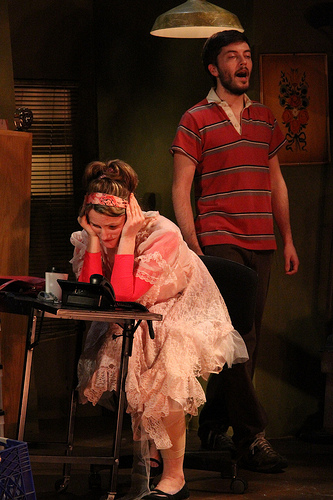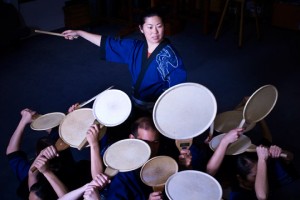It’s not just rock around the clock in Puddletown: It’s dance around the calendar. Autumn, winter, spring and even summer, you just can’t keep this town’s dancing feet down. Art Scatter senior correspondent Martha Ullman West has done her best to keep up with the action, and reports here on some of what’s been kickin’ in town lately.
*
By Martha Ullman West
Portland is having a dance boom, even though those who swim in Terpsichore’s wake are having a hell of a time staying afloat.
 Used to be things were winding down by the time you reached the summer solstice, and there definitely was a time when addicts like me found it impossible to get any kind of movement fix once the Rose Festival was over. Not this year — I actually had to make choices, not having managed the art of being in two or three places at once. So to several emerging choreographers as well as some much more established ones, I apologize for not making it to their performances and herewith offer some thoughts on those I did see.
Used to be things were winding down by the time you reached the summer solstice, and there definitely was a time when addicts like me found it impossible to get any kind of movement fix once the Rose Festival was over. Not this year — I actually had to make choices, not having managed the art of being in two or three places at once. So to several emerging choreographers as well as some much more established ones, I apologize for not making it to their performances and herewith offer some thoughts on those I did see.
I’ll start with Carol Triffle’s new musical Backs Like That, which I saw on June 18th. It’s the latest in her series of quirky commentaries on what Balzac called the human comedy, with more than a little irony implied, and as usual with an Imago piece, it is greatly involved with movement.
In his informative review in the Oregonian, Marty Hughley aptly titled this series “misfit musicals.” But are the four characters — Chloe, the young woman being tried out for a job at Morton, Morton & Morton Trucking and Distribution; LLC, her impossible father who applies for the same job; her boyfriend and her brother who wander off and on the off-kilter set — really misfits? Or are they in fact people who are out of step with our corporate, high tech, over-professionalized times, doing their best to cope with a changing world?
Triffle’s lines are terrific: “Oh right, you were gay twice,” (a paraphrase) says Imago veteran Danielle Vermette, playing Chloe, who is seeking the job. Chloe is talking to her boyfriend, played by Darren McCarthy with all the suave elan of an 18-year-old blind date. He has announced that he has a yen for her brother, hence the sarcasm about being gay.
“It’s not where you’re going that counts, it’s how you get there. And I got here,” Chloe says several times about her job as “executive administrative personal sexy secretary” to the single, remaining and randy Morton, performed with suave tackiness by Jerry Mouawad.
It is, however, the body language of these actors that speaks volumes. Robert Gaynor as the hulkingly ungainly father moves like a malformed superhero; Mouawad, singing a song about his toes (Katie Griesar did the brilliant score) looks completely what the British call gormless. The way in which McCarthy as the boyfriend shambles around the set — a very seedy-looking office with little technology in sight — reveals without words his whiny lack of ambition. And every step that Vermette takes proclaims her sassy spunk, though the shocking pink leggings she wears proclaim it as well. The show is funny, poignant, absurd: fine entertainment and food for thought. I wish I could have gone back to see it again and I can hardly wait for the next in the series.
 It was with more than a little trepidation that the next night I attended Ten Tiny Taiko Dances, which was performing at the Winningstad, reconfigured in the round, as it was originally intended to be. I have enjoyed previous performances of Portland Taiko, but the whole idea behind Ten Tiny Dances gives me the pip. It’s Mike Barber’s concept, namely to challenge a vast array of different choreographers and dancers to perform in a 16 square foot space. The whole idea of restricting dancers’ movement repels me, and I”ve not much enjoyed earlier showcases in the series.
It was with more than a little trepidation that the next night I attended Ten Tiny Taiko Dances, which was performing at the Winningstad, reconfigured in the round, as it was originally intended to be. I have enjoyed previous performances of Portland Taiko, but the whole idea behind Ten Tiny Dances gives me the pip. It’s Mike Barber’s concept, namely to challenge a vast array of different choreographers and dancers to perform in a 16 square foot space. The whole idea of restricting dancers’ movement repels me, and I”ve not much enjoyed earlier showcases in the series.
This was the 20th, and when it comes to Barber himself I really have to eat my words. His was the fifth piece of the evening, a solo to the music of Heather Perkins, called Stockholm. I started to take notes, but was so riveted by the skillful way in which Barber used his body — twisting, jumping, crawling, rolling, upending the canvas platform and getting himself under it — that I said the hell with it, I’ll just watch. I knew of course that he is a fine, fine dancer who can be extremely funny. I first saw him in Gregg Bielemeier’s Odd Duck Lake, in which he danced a sendup of that chestnut of chestnuts The Dying Swan. In Stockholm he succeeded in changing my mind about the uses of a constrained space, because he knows exactly what he’s doing with it and why, and he’s a brilliant dancer.
Apart from Stockholm the most successful of the “Ten Tinies” were those that truly collaborated with the drumming. Omoide Ananda is a quite beautiful conjunction of two Asian dance forms (Japanese and classical Indian); it’s created by Subashini Ganesan and Michelle Fujii, who also performed it. Carla Mann’s Convergence, performed by herself and Eric Skinner, in dialogue with the musicians, worked well not only because of the performers, but also because Mann knows her craft and has a fine-tuned sense of design.
tEEth’s offering, Double Down, pretty much ignored the drumming, eschewed any kind of connection with the audience, and treated us to video of someone’s (Noel Plemmon’s?) hairy belly while live in a tall chair on the platform Plemmons ingested fast food. Call me an old curmudgeonette, but I not only don’t understand the appeal of this stuff — a rehash with technology added of 1920s dadaism and futurism — I’m also deeply, profoundly bored by it. Angelle Hebert and Phillip Kraft, who are tEEth, are extremely talented young people, but they’re repeating themselves and others as if they were artists on the decline, tottering into their sunset years.
As is James Canfield, whose Will was created on the young, extremely good dancers who make up Sarah Slipper’s Northwest Dance Project, which I saw on June 24th in concerts that celebrate the first anniversary of being in their gorgeous space on North Mississippi and Shaver streets.
 Will — which is a tribute to Shakespeare, whom Canfield says in none too coherent program notes has had a big influence on his choreography — zeroes in on Hamlet and Ophelia, danced by the superb Viktor Usov and ditto Andrea Parson, eschewing poetry in favor of brutality as yet again, in Canfield’s work, we get to watch an angry, powerful man drag a vulnerable, fragile woman around the stage. Ophelia as Edie Sedgwick, or Coco Chanel, or Anais Nin, or a Paris Opera Ballet dancer abused by a patron, just doesn’t cut it for me.
Will — which is a tribute to Shakespeare, whom Canfield says in none too coherent program notes has had a big influence on his choreography — zeroes in on Hamlet and Ophelia, danced by the superb Viktor Usov and ditto Andrea Parson, eschewing poetry in favor of brutality as yet again, in Canfield’s work, we get to watch an angry, powerful man drag a vulnerable, fragile woman around the stage. Ophelia as Edie Sedgwick, or Coco Chanel, or Anais Nin, or a Paris Opera Ballet dancer abused by a patron, just doesn’t cut it for me.
Canfield is capable of creating a tender, sensitive pas de deux, God knows — both the balcony and bedroom pas de deux in his lovely Romeo and Juliet come to mind. I wish he’d do more of them.
The best piece on that program was Lauren Edson’s Curved Resistance, in which Samantha Campbell, in her third year as a Project company member, was a knockout as a soloist: elegant, fleet, compelling, and as we say in ballet, beautifully placed. The piece, accompanied by the music of Olafur Arnalds, seems to be about dancing itself, and Lex Dones, Patrick Kilbane, Lindsey Matheis, and Kaitlin Van Rossmann matched Campbell with their passion for their art form.
Slipper’s En(gulf)ed (guess what that’s about!) has its moments, enhanced by some dappled lighting, but doesn’t really come together as a piece. I understand Slipper’s desire to make an artistic statement about the ecological tragedy taking place in the Gulf of Mexico, but while one can take considerable pleasure in watching these young dancers move, the piece is incoherent and inconclusive, and at the end of the day, inadequate.
The show opened with Carla Mann’s disappointing Illumine, featuring all the NWDP dancers in what the choreographer calls a collaboration. A long table with a white cloth and a candelabra are part of the action, danced to a lugubrious score by Arvo Part and Andy Garbi in what amounted to a confusingly dreary dance. Mann’s movement is generous and space-eating, and lord knows the dancers did it well, but what it all meant beats hell out of me. If it was just about movement, because of the music it lacked the kind of dynamics — shifts in mood and energy — that make an abstract work compelling. I’d like to see Mann work with these dancers again and maximize on their energy and joy.
And speaking of young dancers and their joy in movement, on June 12th I journeyed out to Mt. Hood Community College to watch the Center for Movement Arts‘ annual recital because I wanted to see a 15-year-old dancer named Austin Moholt-Siebert give his farewell performance. He’s already left for the Houston Ballet Academy’s summer workshop and will be a full-time student in the Academy in the fall. His self-described dancing style is “sweeping, a space eater,” and that’s accurate — also easy for his six-foot-two, broad-shouldered, long-limbed body.
Most kids that age haven’t a clue what to do with such gifts, but in his graduation solo, Tabu, Moholt-Siebert demonstrated fully just why he was given scholarships to Houston and seven other summer programs, including San Francisco Ballet’s. Musical, precise, and wise beyond his years in his choices on stage, he was a pleasure to watch in Tabu, which was created for him by CMA faculty member Margretta Hansen (a former Oslund + Co and Eugene Ballet dancer). And he was fantastic in former BodyVox dancer Laura Haney’s staging of Bob Fosse’s Steam Heat.
*
PHOTOS, from top:
- Danielle Vermette, Darren McCarthy in Carol Triffle’s “Backs Like That” at Imago Theatre. Photo: Sumi Wu.
- Michelle Fujii and Portland Taiko. Photo: Joni Shimabukuro.
- Samantha Campbell and Andrea Parson at Northwest Dance Project. Photo: Paul Thacker.